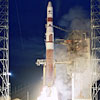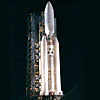 LUNAR’clips
2003
Volume 10, Number 1
LUNAR’clips
2003
Volume 10, Number 1
 LUNAR’clips
2003
Volume 10, Number 1
LUNAR’clips
2003
Volume 10, Number 1
Livermore Unit of the National Association of Rocketry January/February 2003
Copyright © 2003 by LUNAR, All rights reserved.
THE US "war on terror" looks set to inflict some unexpected domestic casualties. Around 8000 amateur rocket enthusiasts say security regulations due to be ushered in this year will crush their hobby.
The problem lies in a part of the US Homeland Security Act that is due to take effect on 24 May. It will force most of the country's "high-power" rocketeers to be photographed, fingerprinted and undergo background checks by the Bureau of Alcohol, Tobacco and Firearms ~TF). They will then need a $25 permit.
"The level of regulation the ATF would impose on our hobby is going to shut high-power rocketry down," says Mark Bundick, president of the National Association of Rocketry in Altoona, Wisconsin. "Can you think of any other hobby, a safe scientific hobby, where people are submitted to fingerprinting and background checks?" he asks.
High-power rocket enthusiasts use a mixture called ammonium perchlorate composite propellant (APCP) to launch their rockets. Unlike toy rockets, high-power models do more than just shoot up a hundred metres or so. Regulated by the Federal Aviation Administration, high-power rockets can reach 10,000 metres, a typical cruising altitude for airliners.
The ATF is adamant APCP needs regulating, however. "The mixture they use is an explosive," says Gary Taylor, a specialist with the ATF's public safety branch in Washington DC. But rocketeers maintain the compound is designed to burn slowly and cannot be made to explode. They say the propellant is exempt from the Homeland Security Act because it falls within the rules for "propellant-actuated devices" which are permitted.
The National Association of Rocketry is awaiting the outcome of a legal case under consideration by the US District Court in Washington DC to get the ATF to change its classification of the propellant. Bundick is hoping for a judgment before the 24 May deadline.
This article was first published in New Scientist magazine (www.newscientist.com), 4 January 2003, and permission to reproduce was requested and acknowledged
For real high-power, try the Delta and the Titan:


All content is the responsibility of LUNAR.
If you have comments or suggestions regarding these web pages,
please contact the 
Copyright © 1992 - 2025 LUNAR